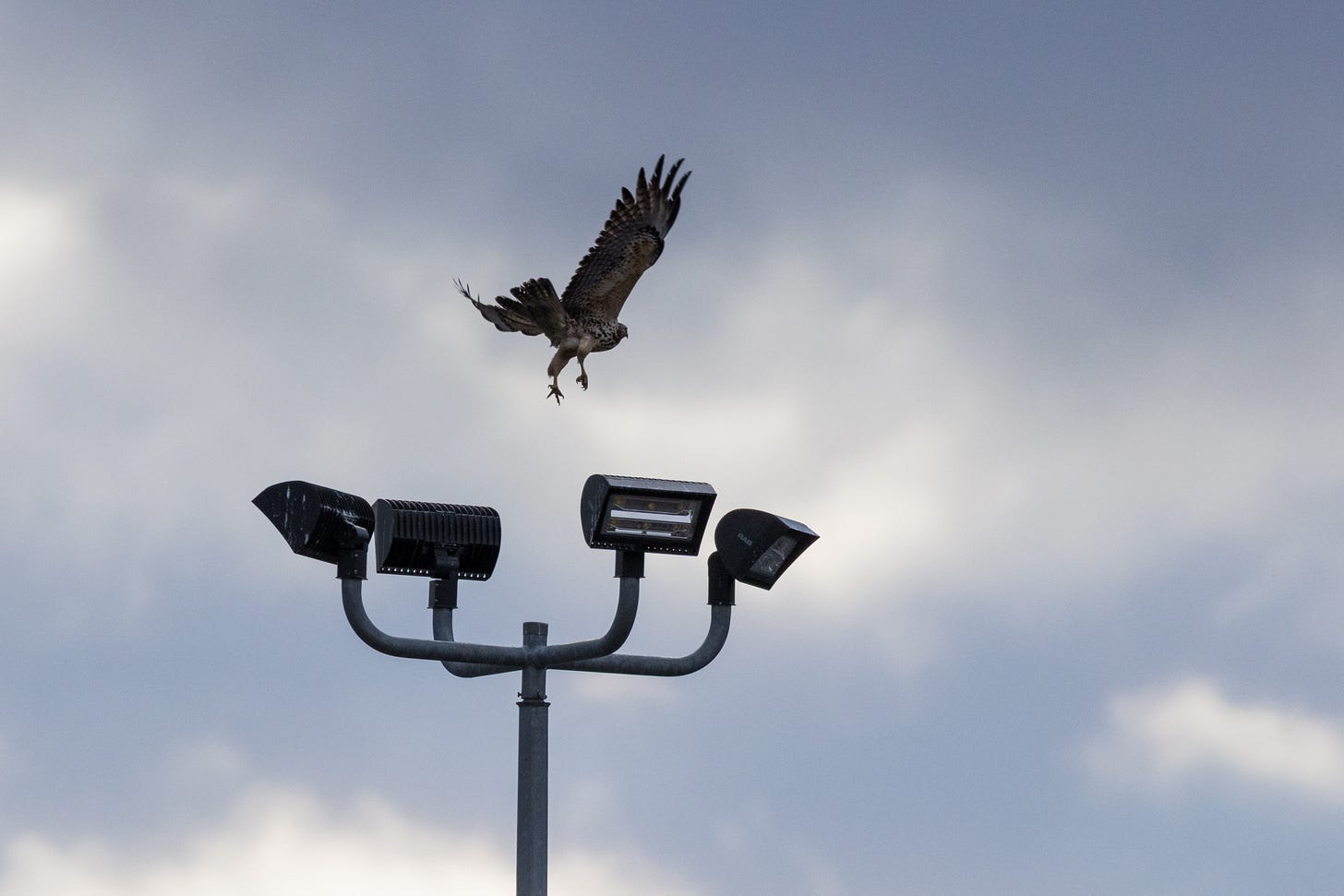For Reasons Known Only to Itself
This rare hawk is back at a recycling center on the Brooklyn waterfront for the third winter in a row.
This complex of buildings on the Brooklyn waterfront—officially the Sunset Park Material Recovery Facility—is New York City’s main recycling plant and one of the largest in North America.
This bird of prey—a Swainson’s Hawk, though up for renaming in the near future—is a species renowned for raptorial elegance and majestic migration. Every year, nearly all of these graceful grassland hunters fly from the North American prairies to southern Argentina and back.
And on Sunday, I saw a Swainson’s Hawk that, for reasons only known to itself, is hanging out at that recycling center for the third winter in a row.
This bird was first spotted, to great excitement, in Staten Island in January 2023. Birder Michael Silber refound it in Green-Wood Cemetery the next month (to even greater excitement; it was the first Swainson’s Hawk ever recorded in Brooklyn). Another birder combed the waterfront to discover its lair at the recycling center, where it was seen nearly every day for a month. (My friend Ryan wrote an excellent account of the hawk’s arrival on their Substack.)
A year after the initial sighting, Silber spotted it again from Green-Wood in 2024, and the next day it was found back at the recycling center. This year, it was again Silber who heralded the hawk’s return about a week ago on a snowy February day—not a kind of day a Swainson’s Hawk is supposed to know about.
A Swainson’s Hawk in the Northeast in midwinter is a freak event. Three winters in a row just doesn’t happen. While a handful of them linger over the winter along the southern fringes of the United States, and it’s not unheard of for them to turn up in the East, on the whole, they go to Argentina during our winter. Brooklyn is 5,000 miles north of where this hawk should be, where a few thousand of its friends are spending the austral summer on the pampas grasslands. Instead, it was hunkering down against gusts of snow-laden wind.
One birder wrote on eBird that the hawk was “looking equal parts majestic and incongruous in the heavy snow. Very nice to reunite with this old friend.”
I saw the hawk myself during its first visit in 2023, but it didn’t show the several times I looked the second time around. When I swung by on Sunday morning to try and spot it, all but a few sooty lumps of that snow had melted. Baled plastics, compressed beyond recognition, towered in great heaps. Sidestepping muddy potholes and a wary herd of Canada Geese, I sifted through swarms of starlings and crowds of crows for an hour, coming up with zero raptors of any description.
I scanned the possible perches one last time, and, on a ledge just below the roofline, there it was, looking as cozy and cute as a hawk can. It had tucked itself against a girder, perhaps with a belly full of rat. It fluffed itself up. It stretched. As it preened, its white chin shone against a rich brown hood and bib, and fluffy cinnamon-colored leg feathers billowed like a pair of parachute pants. It had finally shed its streaky brown immature plumage. At three years old, it’s all grown up.
What was this bird thinking?
The first year might have been an accident— after all, the first time it reached Brooklyn, it was just six months out of the nest. Maybe it was migrating south from the Canadian prairie and made a wrong turn at the Great Lakes.
OK, that’s fine, young birds make mistakes all the time. It could have regrouped on the birding grounds and joined the famous mass migration the next year.
But by some unknown route and for some unknowable reason, it came back here. And it did the same the year after that. It’s never taken the journey that makes its species one of the world’s longest-distance migrants—and still it beat the odds, surviving to adulthood after striking out on its own to do something a Swainson’s Hawk simply never does.
If any wayward raptor species could hack it in New York, though, it’d be this one. Swainson’s Hawks are clever, collaborative hunters, hunting together in massive flocks on their usual wintering grounds in Argentina. On the Great Plains, they’re known to follow tractors to pick off the fleeing rodents. One New Mexico population even plucks swarming bats out of the air. But we still can never know why this one Swainson’s Hawk swapped gophers for rats and grasshoppers for cockroaches.
Sometimes a wild animal just does something weird for no reason a human mind can understand. It forces you to see it on its own terms.
Following the strange story this bird chose for itself didn’t take me anywhere particularly pretty. But if the windswept, gritty Brooklyn waterfront is where this extraordinary hawk wants to make its winter home, I’ll be making the visit.





